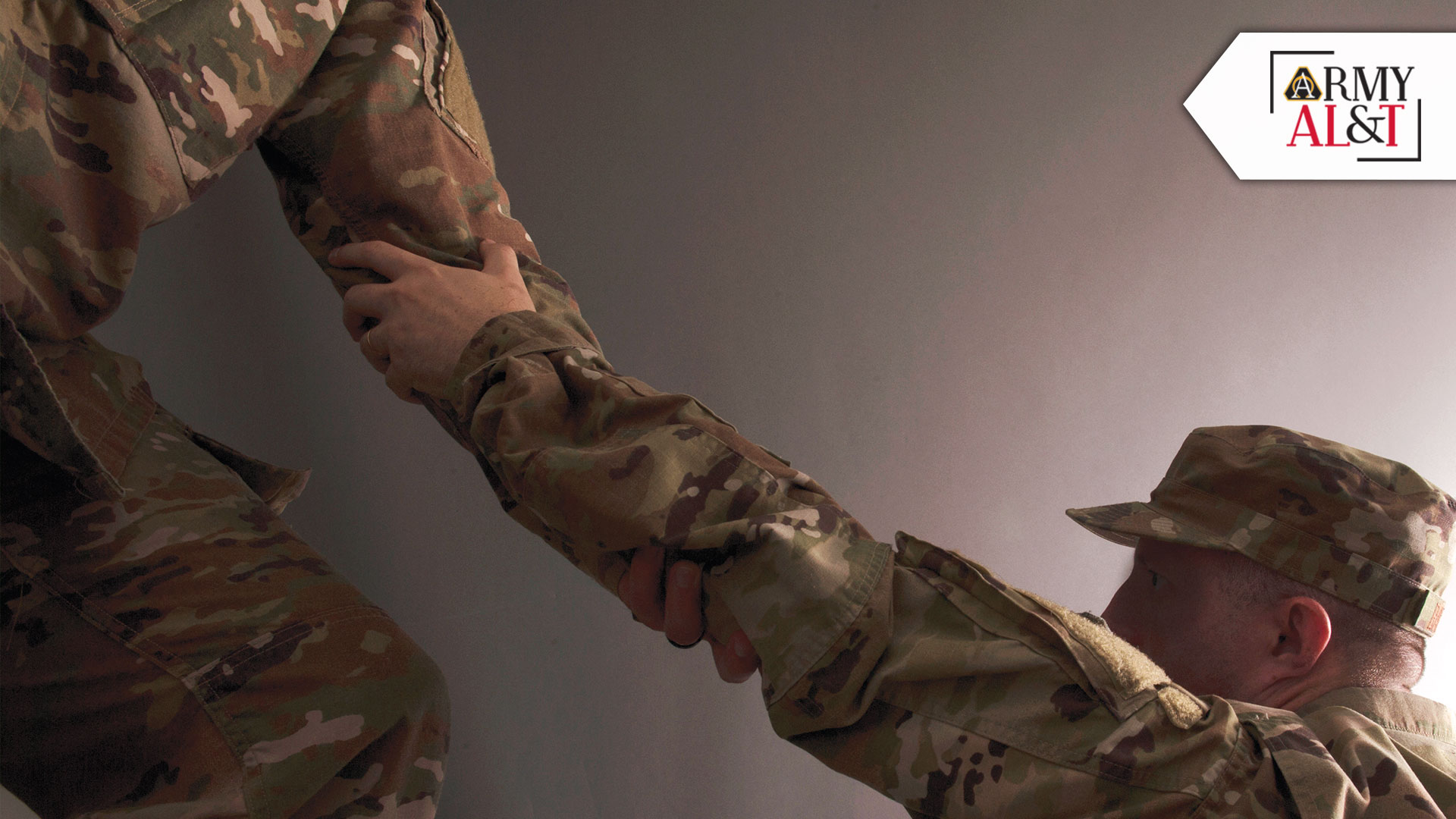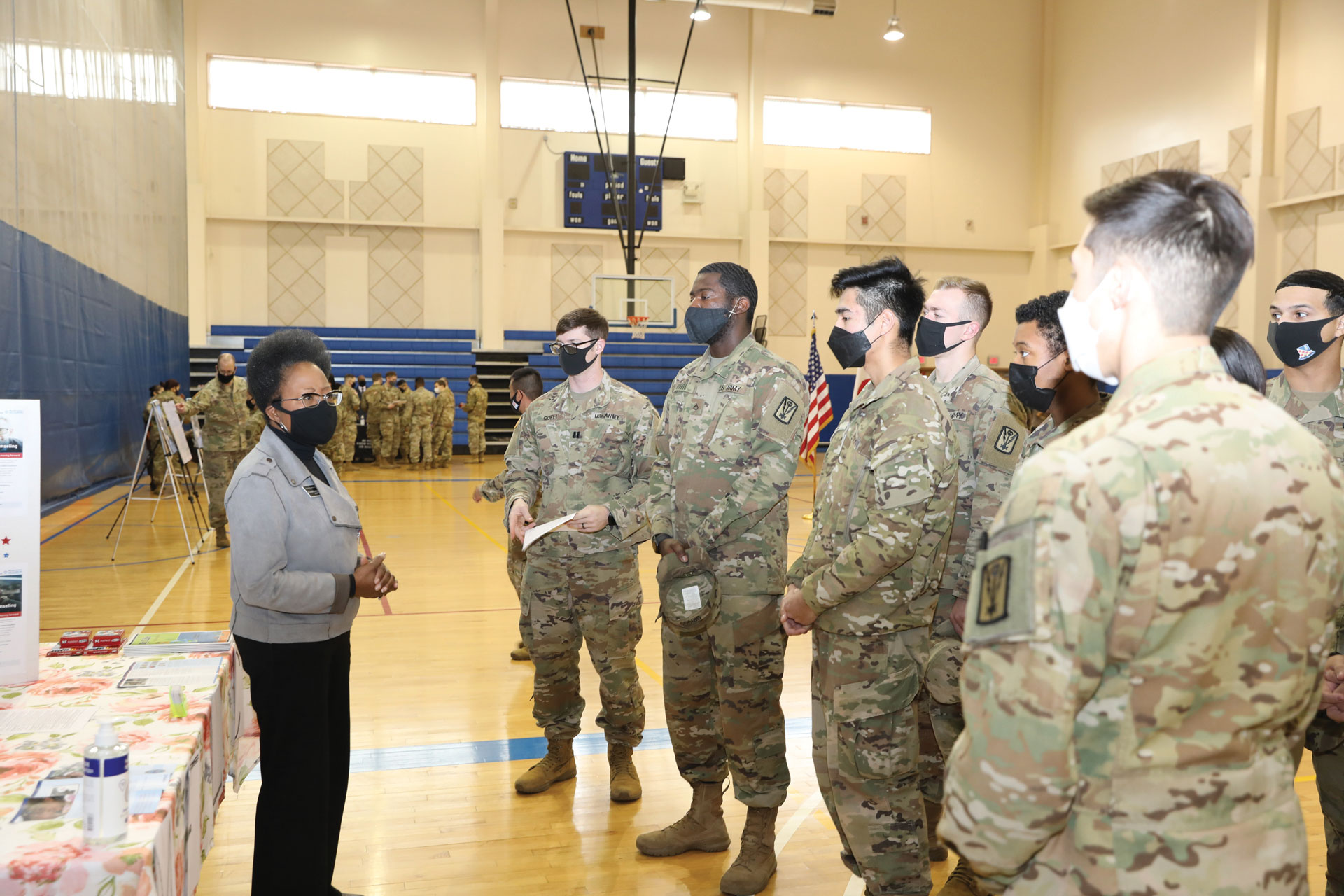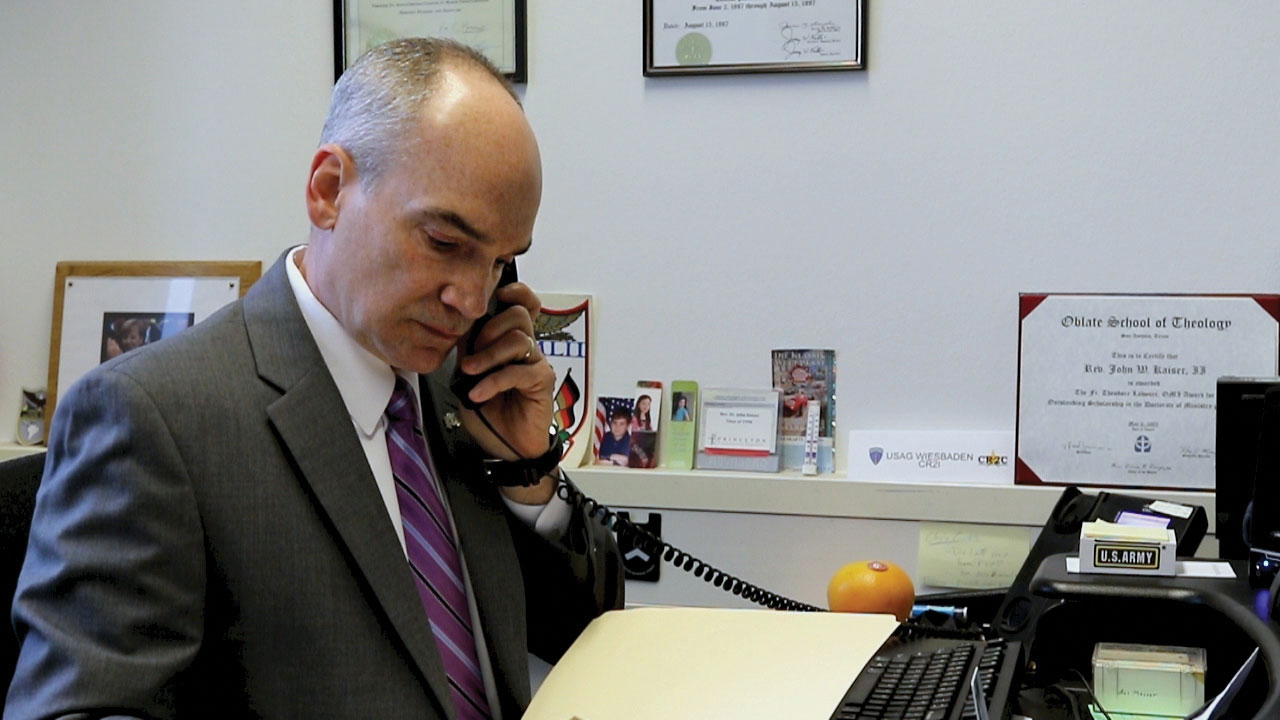
A HAND UP: Living through a pandemic is a challenge for which few people were adequately prepared. It’s important to seek help when needed. (Photo by Staff Sgt. Chad Trujillo, U.S. Air Force)
Life circumstances can be stressful, and a pandemic just compounds stress. For help, look to the EAP and other Army resources.
by Steve Stark
The COVID-19 pandemic came ashore more than a year ago, a silent, motionless hurricane, overwhelming the country and trapping everyone and everything within its eyewall. COVID-19’s slow-motion chaos reordered life and business. And now, as vaccines begin to promise a bit of hope, emerging evidence suggests new variants of the virus might make existing vaccines less effective than originally planned, casting further uncertainty.
It’s enough to make a person lose their grip. But in reality, the present is so difficult that being stressed or feeling like you’re losing your grip is an entirely rational response. “It’s a stressful time,” said Gary Cunningham, an analyst in the Ready, Resilient and Training Division of the Army Resilience Directorate within Army G-1 (human resources), in an interview with Army AL&T.
Stressors that affect one person may not affect another. People who live alone face deep isolation or risk their health to be with others. Families may be spending more time together than they ever have. Such are the stressors that this virus is adding to the usual, Cunningham said. “You have spouses at home who normally wouldn’t be at home all day long, and that could be causing friction. You’ve got kids that are that are trying to log into school” while parents are trying to work. For teachers, he continued, there may be stress “just trying to get 20 kids on the computer and on the same page at the same time.”
For those like Cunningham who work with the Army’s Employee Assistance Program (EAP) and its parent, the Army Substance Abuse Program (ASAP), the pandemic provides an opportunity to better inform the Army enterprise—both within and beyond acquisition—about the availability of those programs. More importantly, the enterprise should know that help from an impartial and confidential person is available when it’s needed.

ON STANDBY: The Army’s Employee Assistance Program (EAP) provides training to supervisors about the resources available and how to support employees in need of assistance. In Germany, Jannan Melendez, the U.S. Army Garrison-Ansbach EAP coordinator said, “We all go through things that are beyond our control and that may be overwhelming at various points in our lives.” (Photo by Amy Stork, U.S. Army Garrison-Ansbach)
OVERCOMING STIGMA
There’s a belief among a lot of Army civilians and military personnel that seeking counseling or other mental health care is a career-ender, said Doryan Dixon, an alcohol and drug control officer with ASAP at Fort Belvoir, Virginia.
That isn’t true, she said in an interview. However, there are things that counselors are bound by law to report—such as when someone could be a danger to themselves, others or the mission. When first talking with someone looking for help, counselors will tell the client what must be reported and warn that if the client tells the counselor any of those things, they must report it.

A PATH TO RECOVERY: Lisa Lofton-Berry, of Fort Bragg’s Employee Assistance Program, an office within the Army Substance Abuse Program, was interviewed in September by local media about National Recovery Month on Fort Bragg, North Carolina. “It’s important to educate [people] that substance use treatment and mental health services can enable those with mental and substance use disorders to live healthy and rewarding lives,” she said. (Photo by Elvia Kelly, Fort Bragg Public Affairs Office)
The Army offers lots of benefits to both military and civilian personnel, but sometimes finding them can be more difficult than taking advantage of them. In the interest of full disclosure, it took a few days for anyone to reach out to Army AL&T after we called the EAP phone number listed on the Fort Belvoir garrison’s homepage and left a message in late January requesting information. That was because her program was short-staffed at that moment, Dixon said.
“I’m really hopeful that we could have someone on within the next two to four weeks,” she said. “But let me make sure that I clarify: We are providing limited services at this time. I’ve actually done intakes and follow-ups and making contacts and providing referrals for physicians.” But Fort Belvoir EAP and ASAP are not presently “doing the full gamut of the program” because of the pandemic.
Currently, Cunningham said, ASAP and the EAP are doing telehealth intake, evaluation, referral and follow-up. In the Before Times, those seeking help from the EAP went to the local office at the installation, filled out forms and spoke with the staff in person. That’s valuable but currently impossible. In addition, ASAP’s mandatory in-person annual training for Army civilians on how ASAP works has been suspended because of the pandemic.
As is sometimes the case with Army programs, the Army EAP works differently than a private sector EAP that might be part of an employee’s health insurance. Many health insurance plans have an EAP benefit that will provide short-term counseling for the employee and family members at little or no cost. (Army civilians and contractors should look at their health insurance plan’s benefits package.) In the Army’s case, EAP coordinators (EAPCs) can do intake and evaluation, Dixon said. EAPCs will work with the individual to find out what resources are available to them—usually through their health insurance plans—and help clients access those benefits, Dixon said.

FOCUSED ON SOLUTIONS: Juanita Meadley, the 501st Military Intelligence Brigade’s Military and Family Life Counselor (MFLC), told groups at her station that the MFLC program is able to provide non-medical, solution-focused counseling for issues such as anger management, communication, relocation adjustment and separation during the brigade’s Behavioral Health Fair on Jan. 28 at Zoeckler Gym on U.S. Army Garrison Humphreys, South Korea. (Photo by Capt. Kurt Van Slooten, 501st Military Intelligence Brigade)
ADDITIONAL HELP IS AVAILABLE
Research has shown that people under stress are not at their decision-making best. But military and civilian personnel alike should keep in mind that there are resources available outside of the EAP and ASAP. Cunningham said, “We try to take advantage of the chaplain on post.” That’s not the only opportunity. For those dealing with grief, for example, churches and other organizations have groups where people can meet—these days, virtually—to share what they’re going through and to find comfort with those experiencing similar challenges. “A really big loss—of a child, you know, loss of a spouse—you’ve just got to find the group that can give you an outlet,” Cunningham said.
There are any number of issues people face that they can get help with by finding the right person or people to talk to—even without a pandemic, he said. ASAP and the Army EAP cover “everything from sexual assault, to suicide to drugs and alcohol … anything to do with … personnel issues pertaining to a Soldier.” The issues aren’t limited to those that are potentially life threatening, or that necessarily involve a Soldier, though the Soldier is the primary focus. Cunningham said the Army also makes services available internationally. “The Army has a counseling program that we run for adolescents in DOD schools” in Europe and elsewhere, for example.
The program has “about 30 counselors right now, placed in DODEA [Department of Defense Education Activity] school systems in Germany and Italy, Korea, Hawaii, that will see DOD dependents and talk issues with them from a counseling perspective. They can actually go into deep counseling with the students.”
Since the pandemic began, Cunningham said, “We have seen an increase in counseling, and it’s more from a stress side.” That includes domestic issues, a broad category.
Every installation has an EAP resource, he said. “Depending on its size, there may be more than one EAPC.”
| CRISES CAN’T WAIT
Those in crisis who need to speak to someone immediately can use the Military Crisis Line (go to https://www.veteranscrisisline.net/get-help/military-crisis-line) to phone or chat. In the U.S., call 800-273-8255 and press 1. From the Military Crisis Line website: In Europe, call 00800-1273-8255 or DSN 118. In Korea, call 0808-555-118 or DSN 118. In Afghanistan, call 001-800-273-8255 or DSN 111. You can also use the Crisis Chat and request a call from a responder. The Veterans Crisis Line “is a free, confidential resource available to any Veteran, even if they are not enrolled in VA [Department of Veterans Affairs] health care or registered with VA. Care does not end when the conversation is over. The Veterans Crisis Line can connect Veterans to their local suicide prevention coordinators, who follow up to coordinate care.” That main number, 800-273-8255 (TALK), is the National Suicide Prevention Lifeline, intended for the general public. Pressing 1 takes callers to the Veterans Crisis Line, which is for both service members and veterans. According to the Resilience Directorate’s website, text chat is also available. Those in crisis, or with loved ones in crisis, can text 838255 to initiate a conversation. The site advises limiting texts to 160 characters. |
HOW TO FIND ASSISTANCE
The Army’s Employee Assistance Program falls under the ASAP umbrella. To find an installation’s EAP or ASAP, go to the installation homepage and search. According to Cunningham, there isn’t a strict standard for how the homepage displays the contact information, so it may be different from one installation to another.
The Army Resilience Directorate’s homepage, covering an array of resources, is https://www.armyresilience.army.mil; or go directly to the directorate’s ASAP page, https://www.armyresilience.army.mil/substance/index.html.
In the left sidebar menu, click on ASAP locations, which will provide a list of all ASAP resources worldwide.
Another resource is the Military and Family Life Counseling Program, accessible via Military OneSource. This program is for military personnel and expeditionary civilians.
Those who would prefer to find resources independently from the Army can reach out to their health insurance provider. Cunningham cautioned that, while an individual provider might be listed as accepting Aetna, for example, they might not be taking new clients.
Another source of information and resources for military personnel and families is Soldier and Family Resources at https://www.army.mil/soldierresources/, which lists a wide variety of services, with links to many different types of needs.
Those searching for services by location can find a list of all garrisons and contact information at https://home.army.mil/imcom/index.php/garrisons. In addition, the Army produces an app called Digital Garrison, which provides information on a wide variety of services, events and other information at each Army garrison, including how to access the EAP or ASAP. It’s available on Google Play for Android devices (https://play.google.com/store/apps/details?id=com.aafes.digitalgarrison&hl=en_US&gl=US) and the Apple App Store (https://apps.apple.com/us/app/digital-garrison/id1484777325) for iOS devices.

CONFIDENTIAL SUPPORT: Dr. John Kaiser, Employee Assistance Program coordinator, works as the community readiness and resilience integrator as well as the health promotion officer at U.S. Army Garrison Wiesbaden in Germany. “Information is key to reducing stress and we want to make sure we are taking care of ourselves through this difficult time,” he said. (Photo by Sgt. Elizabeth Clark, 7th Mobile Public Affairs Detachment)
CONCLUSION
In the same way that ordinary circumstances can be made more stressful by the pandemic, inherently stressful situations—the death of a loved one, children in trouble, divorce, financial issues—can get worse in the strange, silent COVID hurricane. There are resources available, but like a lot of things in government employment, military or civilian, you have to find them. It’s best not to wait until a crisis to do your crisis planning. Do it before the going gets tough.
Read the full article in the Spring 2021 issue of Army AL&T magazine.
Subscribe to Army AL&T – the premier source of Army acquisition news and information.
![]()







